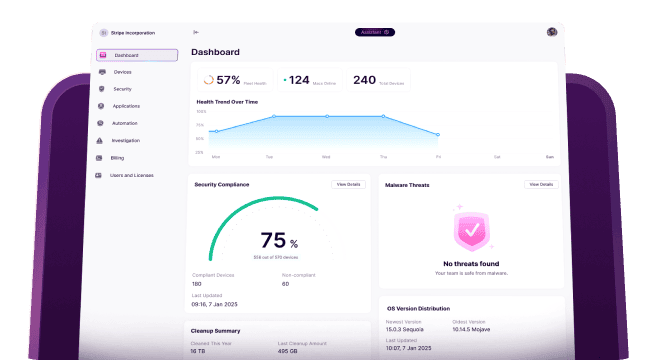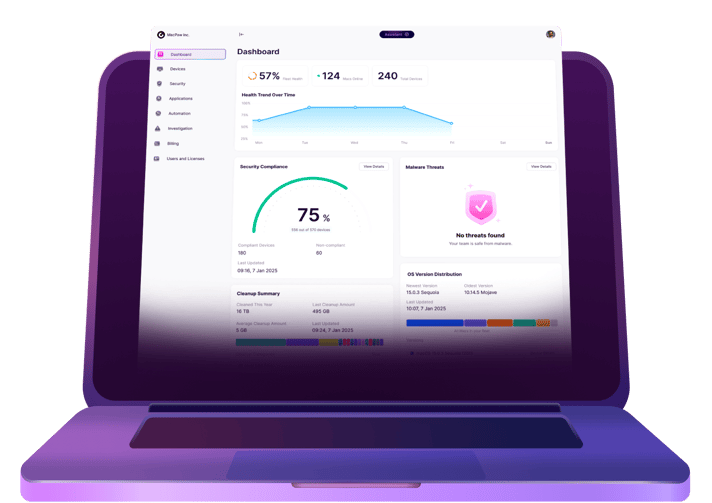Allowing Apple devices, whether macOS, iOS, or iPadOS, in any corporate environment presents no shortage of challenges. But, for small businesses that don’t have teams with knowledge or experience with these devices, it can feel like a nonstarter.
Apple saw this specific need in their customer base and wanted to do something about it. So, it rolled out the Apple Lifecycle Management Program. This article will give you an overview of the program billed to help you with all things Apple product management.
What is Apple lifecycle management?
Apple has been pretty consistent about releasing new operating systems every year for each of their devices, which is great news if you’re a consumer excited about all the fun, new features. But, if you’re an IT professional, that probably feels like a nightmare.
Apple’s lifecycle management was created to help you plan for these inevitable updates. It’s designed to let you create a testing sandbox in your environment. Then, once you’re able to test out new operating system updates and other software betas, you’ll be able to safely roll out the software to devices in your environment.
Phases of Apple enterprise management
To make the entire process a little easier to digest, Apple divided it into four different phases: prepare, evaluate, submit, and rollout.
1. Prepare
When I say Apple has made this process easy to digest and understand, I mean they took it down to the basics. Apple further breaks up this first phase into two steps:
- Set up your team of testers
- Enroll in the AppleSeed for IT program
When it comes to your team of testers, you want to pick trusted individuals. Each individual tester doesn’t have to be an expert in everything your company runs, but across the team, you should have one person that’s very familiar with the process for each line of business.
2. Evaluate
This phase includes quite a bit more documentation. So, grab your pen and paper because the first part of this phase is mapping out your infrastructure. You’ll want to take note of things like:
- IT systems and services (think: WiFi network, VPN servers, Active Directory, etc.)
- Your third-party MDM solution
- All App Store and custom apps
After you have everything mapped out, you’ll need to determine what use cases need to be tested. Apple also recommends assigning each use case to a different tester. This way, you can ensure each one is being thoroughly tested.
3. Submit
Once you've evaluated and tested all your use-cases, it's time to submit the errors and bugs you've found. Apple has created a Feedback Assistance app and website to make it easier for you to notify them of any issues you've encountered while testing.
You can also work with AppleCare for Enterprise to help troubleshoot fixes or workarounds for your issue(s).
But, of course, Apple may not be the only developer at play here. If the issue is with your MDM server or a third-party app, you might want to reach out to those developers to get help from their side.
Taking a multi-pronged approach will ensure that you're able to get to a resolution as fast as possible. Or could help inform fixes for the next round of software updates.
4. Rollout
Once the software's public release is rolled out, you'll want to test this new version before certifying it. Just to make sure there are no further issues with it. But, fingers crossed, it should have theoretically fixed all of the issues you experienced in the beta. When you've verified that's true, then you can certify this new version of the software for release. This will allow all other devices in your environment to download and install the latest update.
How Apple product management can benefit small business
Properly managing the Apple product lifecycle can save your company time and money. But, for your IT team, it can keep them from a world of headaches.
If you’re constantly testing and evaluating new software in beta, you won’t be surprised by as many issues when a user upgrades their device. And if there are issues, your user will experience less downtime because your team will already know how to fix them.
Simply put, Apple product management empowers your IT team and lets them be proactive about the software changes in the environment. Rather than making it feel like they’re playing catch up to get to the latest and greatest.
Lastly, it uniquely positions your company as an early adopter of technology. And in a perfect world, it allows your IT team and users to be excited about software updates. Instead of dreading them and putting them off to the last second.








